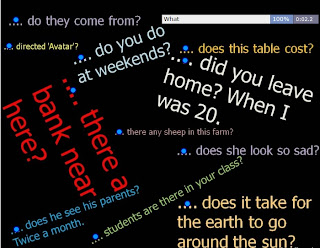Many students have problems structuring questions correctly. It could be that this is due to their teachers asking the questions most of the time, or it could just be that constructing questions in English is somewhat more complicated than in other languages.
Let's run through the main rules again.
First, make sure students know what an auxiliary verb is. An auxiliary verb is a 'helping verb'. It helps another verb (the main one) in the same sentence. Examples are the verb to be, do, have, and the modal verbs, such as can, will, and may:
He is playing football at the moment.
Butterflies can’t bite, but they can fly.
You must speak more English in class.
In a question, an auxiliary verb comes before the subject. If there is no auxiliary, we use DO, DOES or DID. However, DO is not used together when there is another auxiliary verb, e. g. BE.
Do you like hip-hop? (NOT: Like you hip-hop?)
Did you like the film? (NOT: Liked you the film?)
Are you paying attention to me? (NOT: Do you are paying attention to me?)
Is she usually at home in the evening? (NOT: Does she usually is at home in the evening?)
You can answer this type of questions with 'yes' or 'no'.
To ask for more information, we use question words. These usually come at the beginning of the question:
Who said that?
Which is your sister?
Whose pen is this?
What did she want?
Why are you laughing?
We can't answer these type of questions with a yes/no. Remember that we use 'do' only when there are no other auxiliary verbs present.
When the question word is the subject, the question word comes before the verb, and 'do' is not normally used:
Who left the windows open? (NOT: Who did leave the windows open?)
Answer: Cristina left them open. ('Who' asks for Cristina, the subject of the answer)
How many students want to come to my class? (NOT: How many students do want to come to my class?)
Answer: Seven students want to come to your class.
When a question word is the object, do is used:
Who do you want to speak to?
Answer: I want to speak to the headmaster. ('Who' asks for the headmaster, the object)
What do you think of the film?
Answer: I think the film was wonderful!
NEGATIVES
We make negative verb forms by putting not after an auxiliary:
It is not raining (It isn’t raining).
I can’t swim (I cannot swim).
I’m not Chinese.
Do is normally used if there is no other auxiliary verb:
I like the salad, but I don’t like the soup. (NOT I like not the soup.)
I don’t think Sharon is as friendly as María. (NOT I think not...)
Do is followed by the infinitive without to:
I didn’t think. (NOT I didn’t to think, I didn’t thought, or I didn’t thinking)
To practise, take a look at this mind map. It has been adapted from Karenne Sylvester's, from her article, first published on 20th Oct 2010, on Kalinago English, 'The Easiest Speaking Game In The World'.
Draw it on the board, leaving the circle (well, all right, it isn't really a circle) in the centre blank. You can play it as a game, dividing the students in groups. It doesn't really require much explanation, but to make sure they understand, put a topic in the middle (something you've been doing with them recently, e.g. music). Ask a student what she thinks is required. Elicit an example. Elicit a few more from other students.
Then, write a list of topics (or elicit from the students themselves) on the board. Assign one topic to each group. Tell them to ask each other questions based on their topic. Discourage written preparation. Encourage them to speak to each other on the fly. Monitor closely.
And, here's a quick online game. Match the question word or the auxiliary to the right question. Please register, if you haven't done so already, before playing the game, and do leave a comment!



No comments:
Post a Comment
Note: only a member of this blog may post a comment.